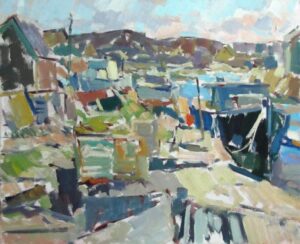Did you know that OPA has been sharing artists’ blog posts for over ten years? We have an extensive collection available to the public on our website. This summer, OPA will be taking Deep Dives into our archives and sharing our favorite posts from years past. Please enjoy this first Deep Dive by the late OPA Master Charles Movalli.
At one of my always stimulating dinners with my late friend Zyg Jankowski, he said to me that the first decision a painter has to make about his work is a spacial one: how “deep” do you want to make the picture? John Carlson felt that every foot into nature counted; Ed Whiney had no interest in such realistic depth and recommended a student plan the composition on-site but walk around a corner to paint it. Over the years, I’ve been of several minds about the question. Under Emile Gruppe’s tutelage, I naturally followed Carlson’s path. Later, I experimented with a flatter approach, one which, carried to an extreme, can make the subject disappear in a series of flat planes.

I rather enjoyed the broken, lively look of such surfaces. but felt that, after awhile, my pictures all began to look alike. They lacked mood. Now modern artists like Hans Hoffmann despised the idea of mood; in fact, he called it a “swindle”– an easy way to make a pictorial statement at the cost of the more important and thoughtful thing: composition. My flat pictures, on the other hand, were all composition. I wandered back to a more “realistic” approach under the influence of artists like Sargent–who has undergone a publishing boom in the last twenty years–Sorolla, and the slew of recently discovered Russians.
I also encountered a Timkov at the old Fleisher Museum which astonished me, since it had both mood and a selective flatness in its approach. Indeed, all the artists I have mentioned knew when to go flat and when to add modeling. Gruppe, for example, would make fun of still-lifes whose pots and bottles were so roundly-modeled that you got “dizzy” looking at them. I also had an important lesson from him early in my career. I had done a rocky hillside with trees against the sky and bushes in the foreground. He came along with a big brush, eliminated a distracting silhouette by pushing the trees out of the top of the frame and mushed the foreground bushes into insignificance. He then drew a few dark lines in the rocks, emphasizing their structure.

Done! That night, I jotted down his criticism: “In full light, you saw only the masses–as the sun went down, you saw the details and put them all in.” Of course, it took a while for this lesson to sink in! Sargent’s famous Lake Louise painting consists of similar flat smudges, and huge, dark-and-light compositional planes, all set off by a minimum of modeling in the foreground water. Such magic is possible when you give up any attempt to copy a subject photographically and instead focus on the large, simple masses that give the scene its visual interest. Once these planes are defined, very little modeling is need to bring “realism” to the subject. That is why I don’t feel that the time I spent on my “flat period” was wasted: on the contrary, it made me even more aware of the importance of simple planes. It taught me how to summarize what I saw, how to make a precis of it–after which, I could put in as much “detail” as I wanted. In short, by adding very little, I could see how much I could get away.
When entering a museum, I am always anxious to see how this sort of slight-of-hand is practiced by the Masters. Not their manual skill, you understand; not, for example, how well they have painted the wings of a fly on a flower. But rather, how they have summarized that flower, reduced it to a few basic planes — and then brought it all to life by an edge or two and a few subtle shifts in value.
Note: for a further discussion of these points, check out YouTube:
